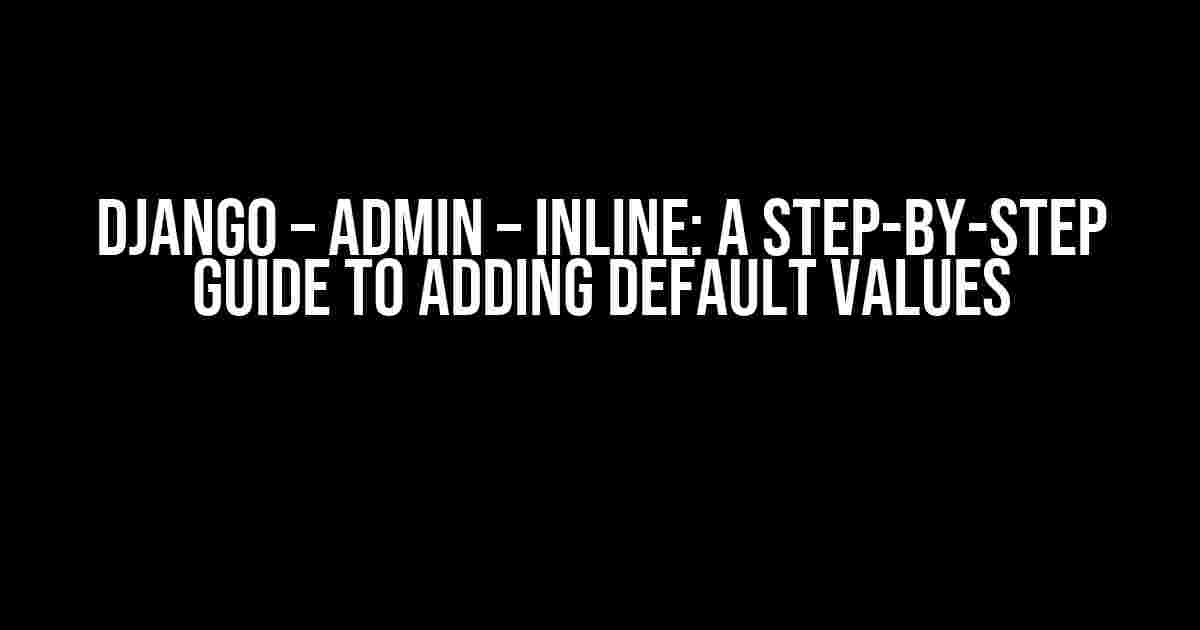Are you tired of manually entering default values for your inline models in Django’s admin interface? Do you wish there was a way to automate this process and make your life as a developer easier? Well, you’re in luck! In this article, we’ll show you how to add default values to your inline models in Django’s admin interface using the `django.contrib.admin` module.
What are Inline Models?
In Django, inline models are a way to edit related models on the same page as the parent model. They’re typically used to represent a one-to-many or many-to-many relationship between models. For example, if you have a `Book` model and a `Chapter` model, you might want to edit the chapters inline with the book.
Why Add Default Values?
Adding default values to your inline models can save you and your users a lot of time. Imagine having to manually enter the same default values every time you create a new inline model. With default values, you can set a starting point for your users, making it easier for them to get started.
Step 1: Define Your Models
Before we dive into adding default values, let’s define our models. In this example, we’ll use the `Book` and `Chapter` models.
from django.db import models
class Book(models.Model):
title = models.CharField(max_length=200)
author = models.CharField(max_length=100)
class Chapter(models.Model):
book = models.ForeignKey(Book, on_delete=models.CASCADE)
title = models.CharField(max_length=100)
content = models.TextField()
Step 2: Create Your Inline Model Admin
Next, we’ll create an inline model admin for our `Chapter` model.
from django.contrib import admin
from .models import Book, Chapter
class ChapterInline(admin.TabularInline):
model = Chapter
extra = 1
@admin.register(Book)
class BookAdmin(admin.ModelAdmin):
inlines = [ChapterInline,]
Step 3: Add a Default Value
Now, let’s add a default value to our `Chapter` model. We’ll use the `default` parameter in the `Chapter` model’s field definition.
class Chapter(models.Model):
book = models.ForeignKey(Book, on_delete=models.CASCADE)
title = models.CharField(max_length=100, default='Untitled Chapter')
content = models.TextField()
In this example, we’ve added a default value of `’Untitled Chapter’` to the `title` field.
Step 4: Update Your Inline Model Admin
Next, we’ll update our inline model admin to use the default value.
class ChapterInline(admin.TabularInline):
model = Chapter
extra = 1
form = forms.ModelForm
default_value_fields = ['title',]
@admin.register(Book)
class BookAdmin(admin.ModelAdmin):
inlines = [ChapterInline,]
In this example, we’ve added the `default_value_fields` attribute to our `ChapterInline` class and specified the `title` field as the default value field.
Step 5: Test Your Default Value
Finally, let’s test our default value. Create a new book and add a few chapters. You should see the default value `’Untitled Chapter’` in the `title` field.
| Chapter Title | Content |
|---|---|
| Untitled Chapter | |
| Untitled Chapter |
Troubleshooting
If you’re having trouble getting your default value to work, here are a few things to check:
- Make sure you’ve defined the default value in your model’s field definition.
- Verify that you’ve updated your inline model admin to use the default value.
- Check that you’ve registered your model admin correctly.
Advanced Topics
In this article, we’ve covered the basics of adding default values to inline models in Django’s admin interface. However, there are some advanced topics you might want to explore:
-
Using a callable as a default value: You can use a callable as a default value by passing a function to the `default` parameter.
-
Using a lambda function as a default value: You can use a lambda function as a default value by defining a small anonymous function.
-
Overriding the default value in the admin interface: You can override the default value in the admin interface by using the `get_form` method in your inline model admin.
Conclusion
In this article, we’ve shown you how to add default values to your inline models in Django’s admin interface. By following these steps, you can save yourself and your users time and make your life as a developer easier. Remember to troubleshoot any issues you encounter and explore advanced topics to take your skills to the next level.
Now, go forth and add some default values to your inline models!
Frequently Asked Questions
Get ready to unlock the secrets of Django Admin Inlines and default values! Here are the top 5 FAQs to get you started.
What is Django Admin Inline and why do I need it?
Django Admin Inline is a feature that allows you to edit related objects on the same page as the parent object. It’s perfect for managing complex data models with multiple related objects. You need it because it simplifies your data management and makes it more efficient!
How do I add a default value to a Django Admin Inline field?
To add a default value, you can override the `formfield_for_dbfield` method in your InlineModelAdmin class. Then, use the `default` parameter when creating the form field. For example: `formfield = forms.CharField(default=’My default value’)`.
Can I use a callable as the default value for a Django Admin Inline field?
Yes, you can! Django allows you to pass a callable as the default value. This is particularly useful when you need to generate dynamic default values. Simply define a function that returns the default value, and pass it as the `default` parameter when creating the form field.
How do I set a default value for a specific Django Admin Inline instance?
To set a default value for a specific inline instance, you can override the `get_formset` method in your InlineModelAdmin class. Then, use the `form` parameter to set the default value for the specific field. For example: `form.fields[‘my_field’].initial = ‘My default value’`.
Can I use a model method as the default value for a Django Admin Inline field?
Yes, you can! Django allows you to use a model method as the default value for an inline field. Simply define a method on your model that returns the default value, and pass it as the `default` parameter when creating the form field.







